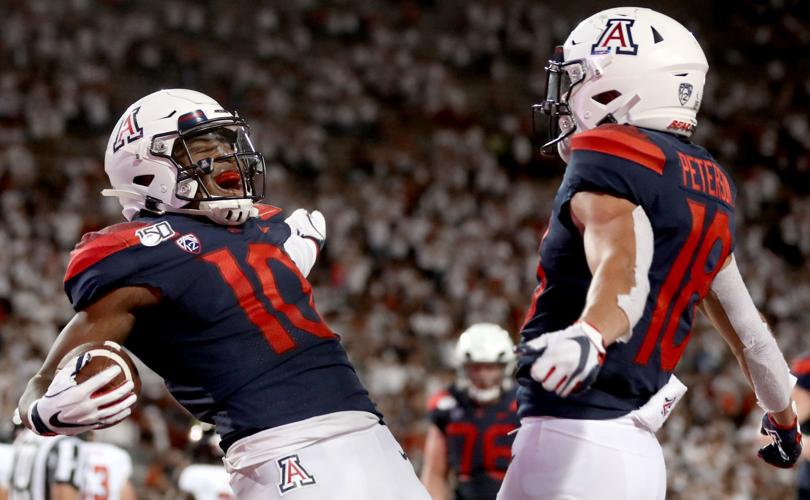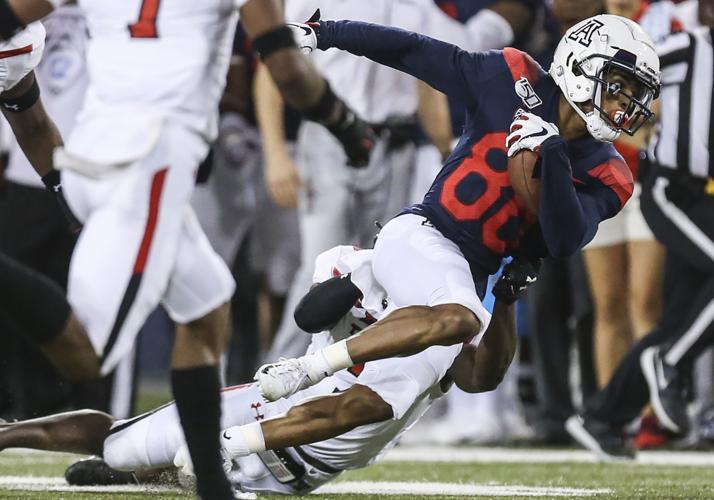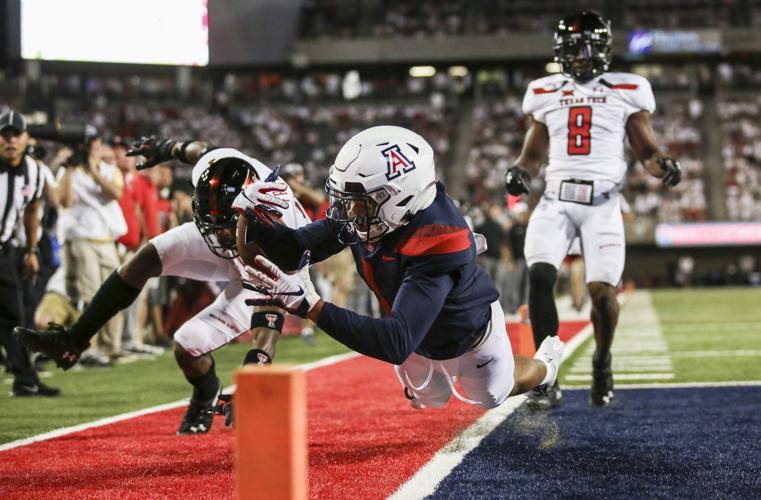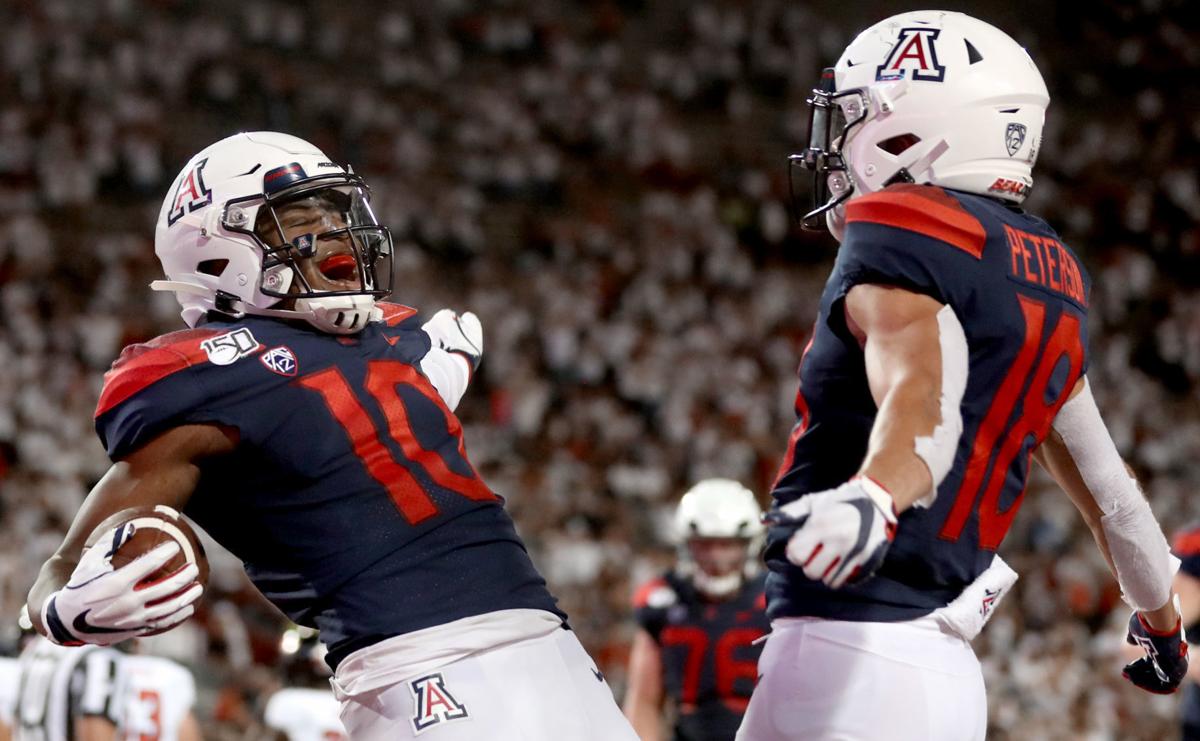
Editor’s note: Each week throughout the football season, we’ll take an in-depth look at the Arizona Wildcats from a statistical perspective.
One of the biggest unknowns for the Arizona Wildcats entering the 2019 season was the composition and competency of their receiving corps.
Three veterans — Shun Brown, Tony Ellison and Shawn Poindexter — exhausted their eligibility at the end of last season. Then, in the spring, the UA parted ways with another vet, Devaughn Cooper.
Arizona’s leading returning receiver, Cedric Peterson, had only 18 catches last season. Only one other returnee, Stanley Berryhill III, reached double figures (14). Peterson was the only returning receiver who had started a game for the Wildcats.
Five games into the season – with Game 6 on tap Saturday against Washington — we have a firmer grasp on what the reconfigured UA receiving corps looks like. Some of the numbers it has produced reveal just how much things have changed.
In this week’s “Cats Stats,” we’ll look specifically at how playing time is being divided and passes are being distributed. We then will discuss the pros and cons (way more of one than the other, we believe) of this new world order.
Let’s start, as we always do, with the facts and figures.
Eleven Wildcats caught at least one pass during Arizona’s 35-30 victory at Colorado last week. That’s the highest total since Kevin Sumlin became the head coach last year. But it wasn’t out of line with what had transpired earlier this season.
Nine Wildcats had at least one reception in three of Arizona’s first four games. In the other, against Texas Tech, the total was eight.

Stanley Berryhill III is among a phalanx of wide receivers who have contributed through the first half of the 2019 season. Berryhill has caught 13 passes through five games. Eight UA receivers have 10 or more catches; nobody has more than 21.
Last season, Arizona had nine players with at least one catch only once — in the blowout loss at Houston in Week 2. The Wildcats had as many as eight only two other times. Their average last year was 6.9. This year it’s 9.2.
For the season, 11 players already have two more or receptions — one more than all of last season (a total that includes two players who had only two catches). Additionally, eight players have reached double figures in catches — also one more than all of last year.
You can see where this is headed: With a dearth of returning, established veterans, more players are getting involved.
Here’s further proof:
Ten players have started at the four receiver/slot/tight end positions through five games, and Arizona has yet to use the same combination twice. Last year, only six players started at those four spots.

Arizona wide receiver Cedric Peterson (18) gets wide open behind Texas Tech defensive back Zech McPhearson (8) to get the ball down inside the Red Raider five late in the third quarter of their football game at Arizona Stadium, Tucson, Sept. 14, 2019.
Six players have led the team or tied for the lead in receptions: Brian Casteel (twice), Tayvian Cunningham (twice), Stanley Berryhill III, Drew Dixon, Jamarye Joiner and Peterson. Only four players held that distinction last season. Brown did it eight times, Poindexter four.
The team leader in catches, Casteel, is averaging 4.2 receptions per game, although that number is on the rise. (Casteel had seven grabs in each of the past two games). Last year’s season-long leader, Brown, averaged 5.3 catches per game.
The extent to which passes are being dispersed tells only part of the story. Arizona also has involved running backs in the passing game in a much more substantial way. Tailbacks have 24 receptions this season, including 11 by Michael Wiley and 10 by Bam Smith. UA backs had only 20 catches in 2018.

Arizona Wildcats wide receiver Drew Dixon (1) reaches for the ballin the end zone during a game at Arizona Stadium Saturday, Sept. 14, 2019. The pass was incomplete.
So what does all this mean?
Five quick takeaways:
1. Arizona doesn’t have a go-to guy, but that’s OK; it has a phalanx of go-to guys. Several previously unproven receivers have made big plays and shown promising signs. Much like at running back, if a receiver or two were to get hurt, the Wildcats have plenty of options.
2. Don’t put too much stock into whoever comes out for the first play – i.e., “starts.” The only receiver who has started every game is Casteel. Peterson didn’t start against Colorado — his first non-start of the season — and led the team with 99 receiving yards. Like it has done with the defensive line, Arizona has rotated liberally at receiver and will continue to do so.
3. The receivers seem to have embraced this arrangement. Peterson and tight end Bryce Wolma said last week that they were OK not having a ton of balls thrown their way as long as the team is successful. “The mentality is, we just want to win,” Cunningham said this week. “So we don’t care who gets the ball. I could get no receptions. But if we win the game, I guarantee everybody will be happy.”
4. Arizona is throwing the ball a little more often this season — 36.4 passing attempts per game vs. 34.1 last year (adjusted for sacks) — but the bigger change is in completed passes. The Wildcats are averaging 23.8 completions per game, up from 18.0 last season. This is a direct result of a meteoric rise in completion percentage. Khalil Tate, Rhett Rodriguez and Joiner combined to complete 55.5% of their passes last season. Tate and Grant Gunnell are at 68.0% this year.
5. Having a variety of viable options — including running backs — gives Arizona a strategic advantage. Each player has a slightly different build and skill set. Opponents can’t come into a game saying, “If we shut down this one particular receiver, we’ve got them.” The only player who truly merits that amount of attention is Tate.
The only possible downside we can see is the “wrong” personnel being on the field in a crunch-time situation. Although each receiver has proved his worth to some degree, they have different specialties and varying levels of experience.
For example: Peterson, the group’s lone senior, probably has the best feel for finding an opening against zone coverage. Tate also might have the highest comfort level with him in that situation (see key third-and-6 conversion from the UA 14 in the first quarter in Boulder).
It’s up to Sumlin and his staff to manage the personnel properly. They have done a good job so far. The robust receiver rotation has been a roaring success, turning a preseason concern into an in-season asset.









